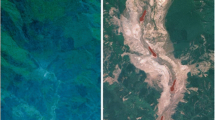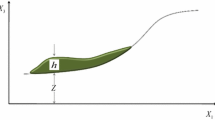Summary
A quantitative procedure for hazard and risk assessment of large landslides that can develop as rock avalanches is discussed in this paper. Reference is made to the IMIRILAND project, where a multidisciplinary methodology has been developed paying particular attention to the landslide modeling process that leads to the quantification of the hazard, i.e. the prediction of the occurrence probability, the involved area and the run-out velocity. The risk assessment methodology is exemplified in the paper with reference to two cases: the Ceppo Morelli and Rosone landslides, both of which are located in the Italian Western Alps. The results of these applications show that, despite the development of sophisticated 3D numerical methods, many uncertainties still remain in the process of modeling large and complex landslides, related in particular to the definition of the probability of failure and the rheological parameters to be used for the prediction of rock mass behavior. However geo-mechanical models are found to be very valuable tools to verify, from a mechanical point of view, the assumptions introduced through the geo-structural and geo-morphological analyses concerning the volume and the kinematics of the unstable mass, and their role is fundamental for the determination of the involved area when mechanical parameters can be assumed with sufficient reliability.
Similar content being viewed by others
References
Berggren, B., Berglund, C. (eds.) (2000): Concerted action for forecasting, prevention and reduction of landslides and avalanche risk (CALAR). Final Report, Swedish Geotechnical Institute, Linköping, Sweden.
C. Bonnard F. Forlati C. Scavia (Eds) (2004) Risk analysis of large landslides in alpine environment: the IMIRILAND project Rotterdam Balkema
Bossalini, G., Cattin, C. (2002): Studio dell’onda di piena conseguente ad una ipotetica frana in località Prequartera. Internal report, Regione Piemonte, Comunità montana Valle Anzasca (in Italian).
Brovero, M., Campus, S., Forlati, F., Ramasco, M., Susella, G. (1996): La frana di Rosone, Valle Orco. In: J. Fourier (ed.), Regione Piemonte & Universitè I. Fourier (eds.), Rischi Generati da Grandi Movimenti Franosi, Programme Interreg I Italy-France, 143–177 (in Italian).
Canuti, P., Casagli, N. (1994): Considerazioni sulla valutazione del rischio di frana. Proc. of “Convegno Fenomeni Franosi e Centri Abitati” Regione Emilia Romagna, CNR-GNDC, Bologna, 1–58 (in Italian).
Castelli, M., Forlati, F., Scavia, C. (2001): Landslides: the questions of the decision-maker and the answer of the modelisation. Proc. 1st Int. Conf. Albert Caquot, Paris, October 2001.
C. Cherubini C. I. Giasi F. M. Guadagno (1993) Probabilistic approaches of slope stability in a typical geo-morphological setting of southern Italy SeriesTitleRisk and reliability in ground engineering Thomas Telford London 144–150
J. Corominas R. Copons J. M. Vilaplana J. Altimir J. Amigò (2002) ArticleTitleIntegrated landslide susceptibility analysis and hazard assessment in the principality of Andorra Nat. Hazards 30 IssueID3 421–435 Occurrence Handle10.1023/B:NHAZ.0000007094.74878.d3
Cruden, D., Fell, R. (eds.) (1997): Landslide risk assessment. Proc. Int. Workshop, Honolulu, 19–21 February, 1997. Rotterdam, Balkema.
De Lotto, P., Moia, F. (2001): Attività di progettazione ed installazione di un sistema di monitoraggio integrato del movimento franoso di Rosone (TO); scenari di rischio. Prog. ISMES 2338, Internal Report, Settore Studi e Ricerche Geologiche ARPA Piemonte (in Italian).
Einstein, H. H. (1988): Landslide risk assessment procedure. Special Lecture, Proc. 5th Int. Symp. on Landslides. Lausanne, Switzerland, Rotterdam, Balkema, 2, 1075–1090.
F. Forlati M. Ramasco G. Susella G. Barla M. Marino G. Mortara (1993) ArticleTitleLa deformazione gravitativi di Rosone: un approccio conoscitivo per la definizione di una metodologia di studio Studi Trentini di Scienze Naturali, Acta Geologica 68 71–108
Friz, E., Pinelli, P. F. (1993): Ricerche sull’area di invasione di valanghe di roccia. Proc. National congress “Fenomeni Franosi”, Riva del Garda, Italy. Studi Trentini di Scienze Naturali, Acta Geologica. 68, 55–65 (in Italian).
Geo&Soft International (1999): ROTOMAP for Windows. Torino, Italia.
Geo&Soft International (2003): ISOMAP & ROTOMAP for Windows (3D surface modelling & rock fall analysis). User’s guide, Torino, Italia.
K. J. Hsü (1975) ArticleTitleCatastrophic debris streams (sturzstroms) generated by rock falls Geol. Soc. Am. Bull. 86 129–140 Occurrence Handle10.1130/0016-7606(1975)86<129:CDSSGB>2.0.CO;2
O. Hungr (1995) ArticleTitleA model for the run-out analysis of rapid flow slides, debris flows, and avalanches Can. Geotech. J. 32 610–623 Occurrence Handle10.1139/t95-063
Mayoraz, F., Cornu, T. H., Djukic, D., Vuillet, L. (1997): Neural networks: a tool for prediction of slope movements. Proc. 14th Int. Conf. on Soil Mech. and Foundation Eng., Hamburg, 1, 703–706.
Morelli, M., Piana, F., Polino, R. (2003): Integrated remote sensing and field structural analyses on large landslide in NW Alps – the IMIRILAND project approach. GeoItalia 2003, 4th Italian Forum on Earth Science, Abstract.
R. Perla T. Cheng D. McClung (1980) ArticleTitleA two-parameter model of snow-avalanche motion J. Glaciol. 26 IssueID94 197–207
Pirulli, M. (2005): Numerical modelling of landslide runout. Doctoral thesis, Politecnico di Torino, Dipartimento di Ingegneria Strutturale e Geotecnica (supervisor: Prof. Claudio Scavia).
P. Prat A. Gens I. Carol A. Ledesma J. A. Gili (1993) DRAC: a computer software for the analysis of rock mechanics problems Liu (Eds) Application of computer methods in rock mechanics Shaanxi Science and Technology Press Xian, China 1361–1368
M. Ramasco T. Stoppa G. Susella (1989) ArticleTitleLa deformazione gravitativa profonda di Rosone in Valle Orco Boll. Soc. Geol. It. 108 401–408
Regione Piemonte (2000): La frana di Prequartera, analisi del movimento franoso e valutazione delle potenziali fasi evolutive e schema del sistema di controllo del fenomeno franoso. Internal Report (in Italian).
Varnes, D. J. (1984): Landslide hazard zonation: a review of principles and practice. Natural Hazard, 3, Paris, France. UNESCO, 63 pp.
J. M. Vengeon D. Hantz C. Dussage (2001) ArticleTitlePrédictibilité des éboulements rocheux: approche probabiliste par combinaison d’études historique et géoméchanique Revue Française de Géotechnique 95/96 143–154
Wiles, T. D. (2005): Map3D user’s manual, Mine modelling (Pty) report, www.map3d.com.
Author information
Authors and Affiliations
Additional information
Author’s address: Marta Castelli, Politecnico di Torino – Dipartimento di Ingegneria Strutturale e Geotecnica, Corso Duca degli Abruzzi 24, 10129 Torino, Italy
Rights and permissions
About this article
Cite this article
Castelli, M., Scavia, C. A Multidisciplinary Methodology for Hazard and Risk Assessment of Rock Avalanches. Rock Mech Rock Eng 41, 3–36 (2008). https://doi.org/10.1007/s00603-007-0151-x
Received:
Accepted:
Published:
Issue Date:
DOI: https://doi.org/10.1007/s00603-007-0151-x




